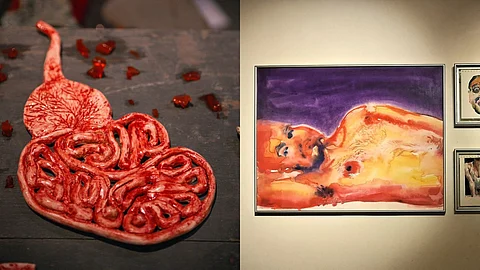
- HOMEGROWN WORLD
- #HGCREATORS
- #HGEXPLORE
- #HGVOICES
- #HGSHOP
- CAREERS
- ABOUT US
- CONTACT US

These are the questions at the heart of Kolkata Queer Arts Month 2024 or Ko:QAM 2.0. In its second edition — titled 'Ghosts & Ghettos' — the month-long arts festival takes on questions of ghosting, ghettoisation, and othering in the context of urban gallery spaces.
In recent years, queer and trans individuals across intersectional lines of class, caste, and gender have had to constantly renegotiate their experience of urban spaces as attempts at progressive legislation have conflicted with ghettos of the human mind. Queerness is so hyper-aware of being relegated to these ghettos — both real and metaphorical — that queer arts practitioners simply cannot ignore this question and its implications. Queerness has never had a cordial relationship with oppressive binaries and it is this very realisation that foregrounds Ko:QAM 2.0.
This winter was one of discontent that saw Kolkata splinter across social, political, and gender fault lines when people took to the streets in righteous anger demanding justice for a doctor who was brutally raped and murdered. At the same time, numerous instances of violence and hate directed at LGBTQIA+ individuals went unnoticed and unreported.
Set against this dichotomy of the city — and the many cities that exist in its interstitial spectral spaces, unknown and unseen by most — Ko:QAM 2.0 searches for answers to these questions and conundrums through a series of conversations, displays, workshops and presentations. Taking place in three separate sites, these interventions mark a series of shifts in perspectives and renegotiates how we understand the concept of the gallery space as well as the ethical and cultural implications that define what gets put on display, and consequently, what gets devalued and brushed aside.
In all three sites, the exhibitions explore whether contemporary gallery spaces — often defined as spaces of creative expression — are also paradoxically sites of exclusion because of their normative, institutional structures. These exhibitions confront the implications of the 'ghetto', a term that resonates deeply within queer and trans communities, who have historically faced marginalisation across lines of class, caste, race, and gender. Through these explorations and interventions, Ko:QAM 2.0: Ghosts & Ghettos challenges us to reconsider the boundaries between the mainstream and the 'other', and the oppressive binaries that often dominate cultural spaces.
Ghosts & Ghettos: Kolkata Queer Arts Month 2024 (Ko:QAM 2.0) is on view at Aranya Bari, Anjali-Pratyay, and Experimenter — Hindustan Road till January 20, 2025. Learn more about Ko:QAM 2.0 here.
If you enjoyed reading this, here's more from Homegrown:
Inside An Indian Art Collective That's Making A Case For The Unpolished & Unfinished
'The Imaginary Institution Of India' Captures The Turbulence & Resilience Of A Nation
Demons, Dragons, & Discovery: Swayam Parekh's Silent Comic Is About Finding Yourself
